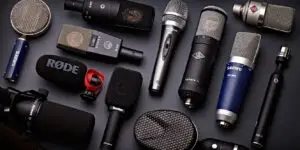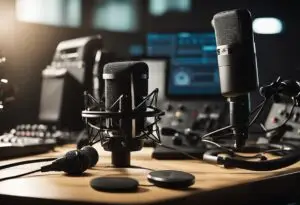Ever wonder why your favorite podcast hosts sound so smooth, rich, and downright pro? It’s not just because they have a fancy microphone perched next to them — although, yes, that does help. Creating that deliciously warm, intimate podcast voice is actually a blend of smart gear choices, a few clever techniques, and a sprinkle of post-production magic.
Let’s peel back the curtain and dive into what makes up the voice that hooks us for hours.
🎙️ First Up: The Mic Matters (But It’s Only the Beginning)
When you picture a podcast setup, you probably imagine a classic studio microphone — maybe even a big, impressive-looking condenser mic with a pop filter hanging in front of it. You’re not wrong! This is the traditional “podcast mic” look and sound.
But what about those cool videos where the mic is hidden off-camera — like when someone’s using a shotgun mic? That leans more into television or film territory. It gives a different texture to the voice — less cozy coffee chat, more crisp movie dialogue.
For true podcast vibes, it’s not just having a good mic — it’s how you use it.
Enter the Magic of the Proximity Effect
One of the biggest reasons podcast voices sound so dreamy is something called the proximity effect. It happens when you get up-close and personal with your microphone. Like, reeeally close.
By speaking closely into a podcast or broadcast mic, your lower tones get naturally boosted, creating that deep, warm, velvety sound you associate with radio DJs and your favorite podcasters. It’s not just aesthetic either — being close to the mic changes the entire emotional connection with the listener. It feels intimate, like they’re right there with you.
If you place that same fancy mic across the room? Poof! There goes the magic.
🧙♂️ The Real Wizardry: Post-Production Polish
Even with the best mic technique, the real sparkle often happens after the recording. There are three behind-the-scenes tricks every professional podcaster (and their editor) knows by heart:
1. Compression:
Compression is like a gentle squeeze for your voice. It smooths out the highs and lows, making loud bits softer and quiet bits louder. The result? A steady, even voice that’s easy to listen to — no sudden shouty moments or whispery drop-offs.
2. EQ and De-Essing:
EQ (equalization) shapes the character of your voice by boosting or cutting specific frequencies — giving it more bass, softening harsh mids, or adding sparkle to the highs. De-essing is a sneaky little trick that tames harsh “S” sounds so you don’t accidentally blast your listeners with every syllable.
3. Noise Reduction:
Even the best recordings have a bit of hiss, hum, or background buzz. Enter noise reduction. With one click, modern plugins can scrub away that annoying noise floor, leaving behind pure, clean vocals. It’s like washing your voice until it sparkles.
🎧 Why Your Expensive Mic Might Still Sound Meh
Here’s the kicker: buying a shiny, expensive microphone doesn’t automatically make you sound like your podcast heroes. If you skip the mic technique and the post-production, you might still end up disappointed.
That rich, buttery voice you dream of? It’s crafted — part art, part science, and a whole lot of thoughtful editing.
Bottom Line:
The podcast voice isn’t just about having gear — it’s about how you use it, how you process it, and how close you are to it.
So if you’re setting up your own podcast, remember: hug your mic, trust your editor (or learn a few plugins yourself), and before you know it, you’ll be dishing out those sweet, pro-level sounds too.








